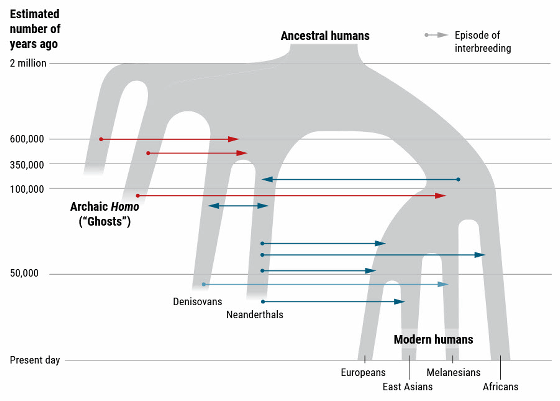Simulation reveals what kind of mating was done by ancient humans

A simulation of how ancient Neanderthals and
Neanderthal-Denisovan ancestors interbred with a distantly related hominin | Science Advances
https://advances.sciencemag.org/content/6/8/eaay5483
Originally, researchers analyzed ancient human mating by extracting DNA sequences from ancient human fossils and searching for equivalent sequences in the modern human genome. With this method, it was possible to analyze the mating of Neanderthals and Denisovans up to 200,000 years ago, but it was not possible to extract the complete gene from human ancestors older than 200,000 years ago. Therefore, population genetics researchers have developed gene analysis tools for discovering old DNA from the genes of living people, and have found evidence of old mating from the analysis tools.
Rogers' research team has discovered the potential for various mating gene mutations in the genes of human populations, including Europeans, Asians, Neanderthals, and Denisovans. The research team used analysis tools to simulate eight scenarios of how genes change before and after mating with other human populations, and found that ancient humans separated from other humans about 2 million years ago. It was suggested that it may have been crossed with an undiscovered human population. It is speculated that the 'unknown human beings' suggested by the analysis tool are likely to be of the same generation as Homo erectus .
In the graph below, the vertical axis is the chronological table, the horizontal axis is each human being, and the arrow shows which human beings affected which human gene by mating. Rogers' simulations show that at least two ancient humans (Archaic Homo) and Neanderthals, Denisovans, and Modern humans have crossed. , The relationship is shown by the red line in the figure below. It also suggests when modern human ancestors mated with Neanderthals and Denisovans, a relationship shown by the blue line.

There have been several studies suggesting unknown humans, such as genes found in fossils, but Rogers' analysis is particularly compelling, according to Murray Cox, a biologist at Massey University in New Zealand. Claims to be. A study at the University of Adelaide in Australia also suggested the existence of an unknown human being.
Traces of 'two types of extinct unknown human beings' exist in the DNA of modern humans --GIGAZINE

On the other hand, some researchers have pointed out that Rogers' research requires detailed investigation. One of the problems is that there are multiple studies showing that modern human ancestors mate with ancient Africans at a time different from what Rogers claims. In addition, as a result of analyzing the genomes of 405 people from four populations in West Africa registered in the ' 1000 Genomes Project ', a genome catalog around the world, many gene mutants not found in Neanderthals and Denisovans Has been discovered, and the mutant has different results from Mr. Rogers's claim.
Studies revealing the mating of these ancients emphasize that different humans could be mated with completely different humans, even if the details were different, says Science Advances writers. Ann Gibbons said.
However, modern Homo sapiens do not have the potential to gain diversity by mating with other human populations. Karina Schulbush, a population genetics researcher at Uppsala University, points out that the absence of other human populations in modern times is one of the reasons why extinct human populations are not easily found. 'It's a dangerous situation for a large, densely spread species like Homo sapiens to have little genetic diversity,' said Schulbush.
Related Posts:
in Science, Posted by darkhorse_log






